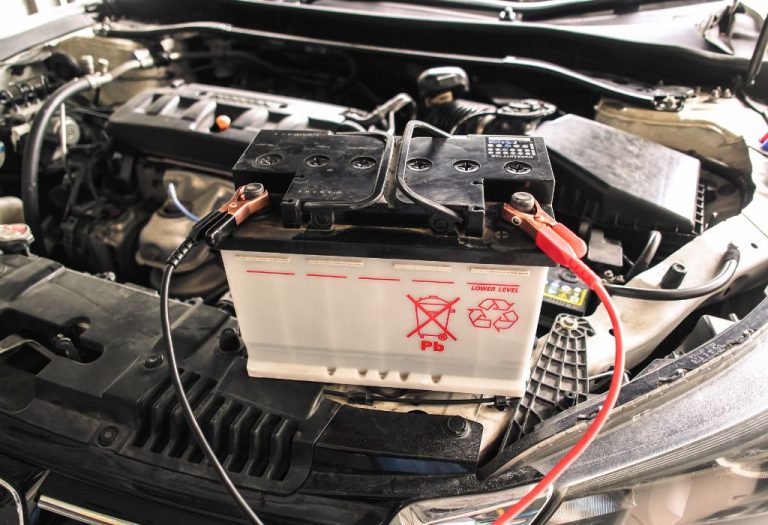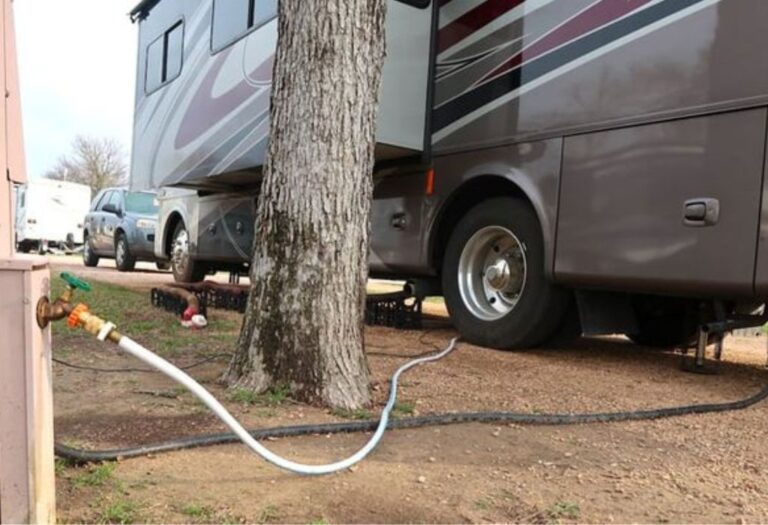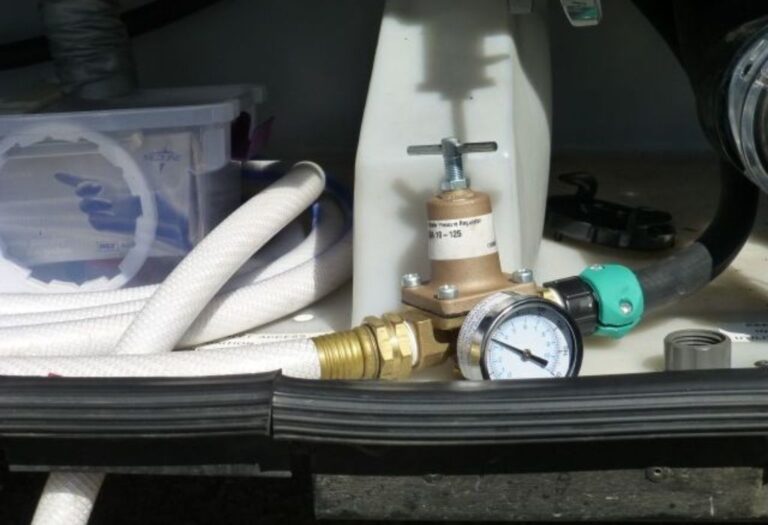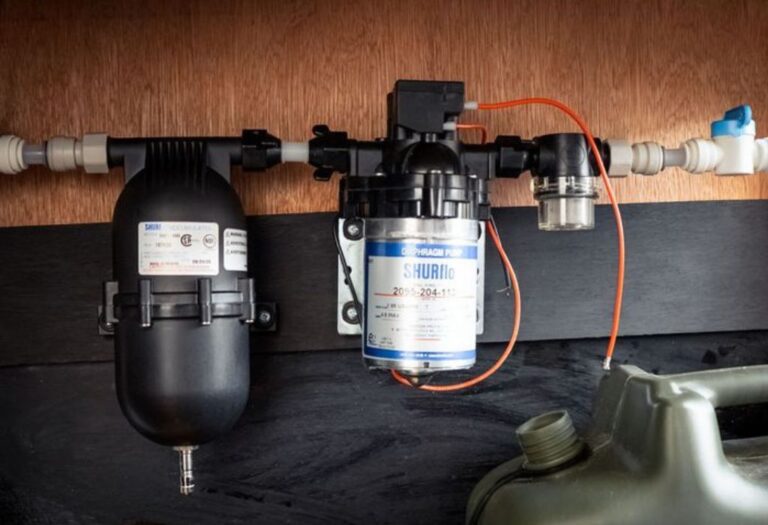How to Use a Water Pressure Regulator on RV
High water pressure can be one of the most overlooked hazards for RV owners. Without regulation, bursts of water from campground hookups can damage pipes, fittings, and appliances, leading to costly repairs and inconvenient downtime.
A water pressure regulator is an essential tool to protect your RV’s plumbing system. It ensures that water enters your RV at a safe, consistent PSI, safeguarding faucets, showers, and water heaters from sudden pressure spikes. According to RVTravel.com, excessive pressure above 60 PSI can severely damage RV plumbing and appliances (rvtravel.com), highlighting the importance of using a regulator every time you connect to city water.
Many RV owners are unsure how to install, adjust, and maintain these devices properly. Learning how to use a water pressure regulator on your RV can prevent leaks, improve water flow, and extend the life of your water system. This guide explains what regulators do, step-by-step installation, adjustment tips, common mistakes to avoid, and maintenance practices to keep your water system safe and reliable.
What Is a Water Pressure Regulator and Why It’s Essential for RVs

A water pressure regulator is a device designed to reduce incoming water pressure to a level that RV plumbing can safely handle. Without one, high-pressure water can burst hoses, damage faucets, and stress appliances such as water heaters.
How It Works
The regulator automatically limits water pressure from campground spigots or city connections. It ensures a steady flow of water to your RV’s system, preventing spikes that could otherwise cause damage.
What does a water pressure regulator do?
Controls water pressure entering the RV to prevent plumbing damage.
Why is it essential for RVs?
Campground water pressure can exceed safe PSI levels for RV plumbing.
What PSI range is safe for RV plumbing?
Typically 40–60 PSI.
Can I use it for both motorhomes and trailers?
Yes, regulators work for most RV types.
Does it affect water flow?
It maintains safe flow while preventing excessive pressure.
Tools and Materials Needed
Proper installation requires the right tools and materials to ensure a secure connection and accurate PSI. Using the correct fittings and hoses prevents leaks and maintains consistent water flow.
Common Tools and Parts
- Water pressure regulator (RV-rated)
- Drinking water hose
- Teflon tape or pipe sealant
- Hose washer
- Water pressure gauge (optional)
Do I need a special RV regulator?
Yes, it should be rated for potable water and RV PSI limits.
Is Teflon tape required?
Recommended for a tight, leak-free connection.
Do I need a gauge?
Optional but helpful for verifying PSI.
Can I use a standard garden hose?
Only if rated for potable water; use RV hoses when possible.
Are extra washers needed?
Yes, to prevent leaks at threaded connections.
Step-by-Step Installation
Installing a water pressure regulator is simple but requires care to prevent leaks and ensure accurate PSI. Follow these steps to connect your RV safely to city water.
Installation Steps
- Turn off the campground water supply and flush hoses.
- Attach the regulator to the water spigot.
- Wrap threads with Teflon tape and insert a washer.
- Connect your RV drinking water hose to the regulator.
- Optional: attach a water pressure gauge after the regulator to verify PSI.
Can I install it without turning off water?
No, always start with the spigot off.
Which way should the regulator face?
Outlet toward the RV, inlet to the spigot.
Do I need additional adapters?
Only if hose and spigot connections differ in size.
Should I tighten by hand or with a wrench?
Hand-tighten first; use a wrench only if needed to prevent leaks.
Can I leave it attached permanently?
Yes, but remove it during freezing weather to prevent damage.
How to Adjust Water Pressure
Some regulators are adjustable, while others are preset. Adjusting PSI ensures your RV plumbing receives safe pressure without compromising water flow.
Tips for Adjustment
- Check regulator instructions for an adjustment knob or screw.
- Use a pressure gauge to measure PSI at the RV inlet.
- Adjust gradually in small increments to avoid sudden bursts.
How do I know the pressure is safe?
Keep it between 40–60 PSI.
Can I adjust a preset regulator?
Not always; follow manufacturer instructions.
Should I adjust while water is running?
Yes, measure PSI while water is flowing.
Does adjustment affect flow?
Minimal impact if PSI is set correctly.
Can it protect appliances like the water heater?
Yes, preventing overpressure reduces strain on appliances.
Common Mistakes and How to Avoid Them
Incorrect installation or use of a water pressure regulator can lead to leaks, bursts, or damage. Awareness of common mistakes prevents costly repairs and plumbing emergencies.
Mistakes to Avoid
- Skipping Teflon tape or washers
- Connecting to frozen hoses or spigots
- Over-tightening threads
- Using a regulator rated above RV PSI limits
- Neglecting to monitor pressure
What happens if I skip washers?
Leaking connections are likely.
Can frozen water damage the regulator?
Yes, always remove it during winter.
Is overtightening harmful?
Yes, it may crack the regulator or hose.
What if PSI exceeds RV limits?
High pressure can burst pipes and damage appliances.
Should I check connections regularly?
Yes, to prevent leaks during travel.
Maintenance and Troubleshooting

Regular maintenance ensures long life and consistent performance. Troubleshooting helps prevent water system failures while on the road.
Maintenance Tips
- Inspect washers and threads for wear.
- Flush the regulator periodically to prevent mineral buildup.
- Store regulator in a dry place when not in use.
- Replace worn or cracked hoses.
How often should I inspect it?
Every season or before long trips.
Can mineral buildup affect PSI?
Yes, reducing flow and accuracy.
How do I clean the regulator?
Flush with clean water or mild vinegar solution if needed.
Should I use the same regulator every trip?
Yes, consistent use is safe if maintained.
Is replacement expensive?
Typically $20–$40 depending on brand and PSI rating.
Benefits of Using a Water Pressure Regulator
Using a regulator protects RV plumbing, water appliances, and ensures consistent water flow. It prevents costly damage and improves comfort while traveling.
Key Advantages
- Prevents overpressure damage
- Protects water heater, pump, and pipes
- Reduces leaks and repair costs
- Maintains consistent flow at faucets and showers
- Complies with RV safety standards
Does it save money?
Yes, by preventing pipe or appliance damage.
Will it improve shower pressure?
Keeps pressure consistent without spikes.
Is it required in campgrounds?
Not always, but highly recommended.
Can it prevent leaks in old RVs?
Yes, especially for aging pipes.
Does it prolong water pump life?
Yes, by reducing strain from overpressure.
Conclusion
Learning how to use a water pressure regulator on RV is essential for protecting plumbing, appliances, and ensuring safe water flow. Proper installation, adjustment, and maintenance prevent leaks, bursts, and damage, making your RV experience safer and more enjoyable.
Invest in an RV-rated regulator, follow the installation steps carefully, and monitor PSI regularly. Doing so ensures your RV plumbing system remains reliable, efficient, and stress-free on every trip.
I’m David R. Coleman, the founder, lead writer, and lifelong tool enthusiast behind GarageToolPro.com. With years of experience in automotive repair, woodworking, and home DIY projects, I created this platform to share practical tips, detailed tool reviews, and step-by-step guides that help mechanics, hobbyists, and homeowners get the job done right the first time.






